
The world of content marketing is a bit like navigating a bustling city. Every corner brings a new trend, and just when you think you have mastered the fastest route, a detour shakes up your plans. In 2025, the landscape is evolving faster than ever, with artificial intelligence taking the wheel, audiences demanding authenticity over perfection, and personalisation becoming the currency of connection. These are not just passing fads, they are the direction-setters for how brands will captivate, engage, and retain their audiences, all of which point to the emerging content marketing trends shaping the year ahead.
If you are ready to stay ahead of the curve, this guide will equip you with the knowledge to thrive. We will explore the top content marketing trends driving the industry forward. Stay with us and discover the insights that can transform your strategy and ensure your brand is not just part of the conversation but leading it.
What’s Inside:
- Understanding Content Marketing
- Content Marketing in Australia 2024
- Top Content Marketing Trends for 2025
- Prepare for 2025: Stay Ahead of the Content Marketing Trends
Understanding Content Marketing
In an era dominated by information overload, people want content that is authentic, insightful, and helpful. Traditional advertising methods are becoming less effective, with consumers actively avoiding interruptions.
Content marketing, however, provides an opportunity to connect meaningfully with audiences by offering value, educating, or entertaining them. It nurtures long-term relationships, builds brand authority, and drives organic growth, making it a cornerstone of modern marketing strategies. That’s why content marketing is important in the field of digital marketing.
Content Marketing in Australia 2024
The content marketing industry in Australia continues to demonstrate strong growth, with a market size of $453.2 million. Over the past five years, the sector has expanded at a compound annual growth rate (CAGR) of 4.3%, reflecting the increasing importance of content-driven strategies in businesses across the country.
This trend is further evidenced by the rise in the number of content marketing businesses, which have grown at a robust CAGR of 9.2%. The Australian market is clearly embracing the shift towards more engaging and informative digital marketing, with brands investing in content creation, SEO, and social media to better connect with their audiences.
Source: ibisworld.com
Top Content Marketing Trends for 2025
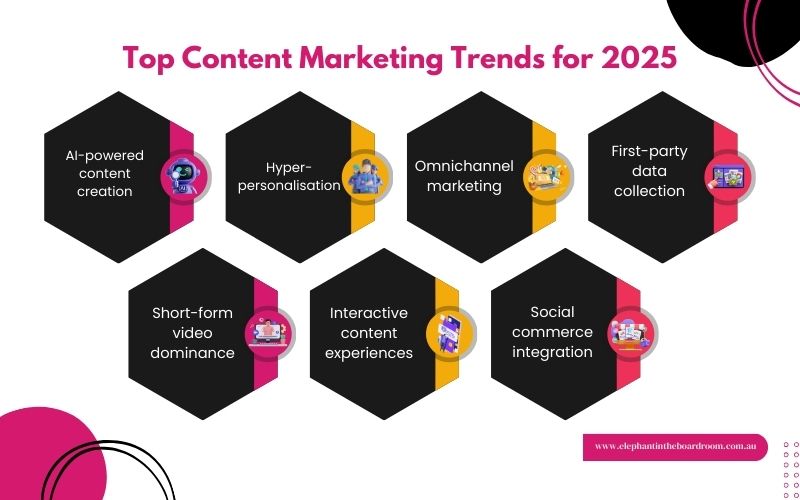
As we move closer to 2025, businesses are gearing up to stay ahead of the curve in content marketing. Here are the key content marketing trends that will define the next year, and what you need to do to leverage them for success:
AI-Powered Content Creation

AI is no longer just a buzzword, it is a central pillar in content marketing. As of 2024, 67% of small businesses worldwide have integrated AI into their SEO strategies for businesses. This adoption is not just a passing trend, 68% of those leveraging AI have seen marked improvements in content marketing ROI, with nearly all (99%) using a mix of tools to optimise both SEO and content creation.
In 2025, AI’s role in content marketing will continue to grow, enabling businesses to produce high-quality, personalised content at scale. AI-driven tools will help marketers identify trending topics, optimise content for SEO, and even create customised content based on audience preferences.
Hyper-personalisation
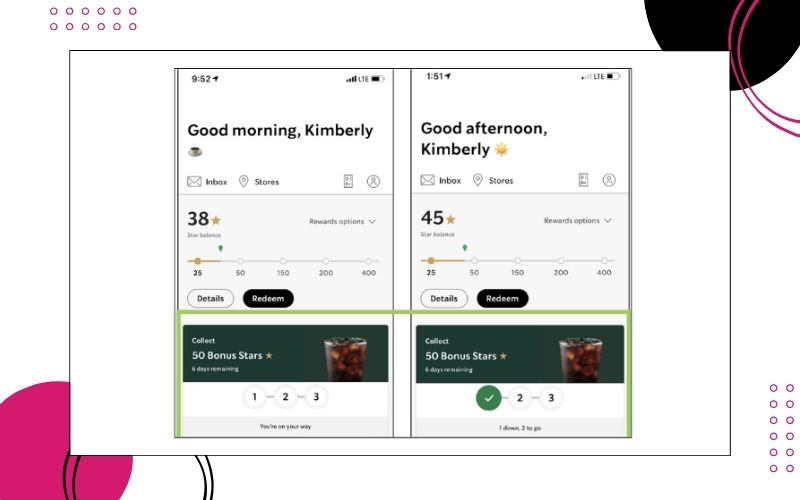
As we head into 2025, one thing is clear, hyperpersonalisation is no longer a trend, it is a necessity. The days of relying on generic, one-size-fits-all messaging are officially over. If you are still sending out the same content to your entire audience, it is time to rethink your strategy. The shift towards personalisation is undeniable, and the demand for tailored experiences is higher than ever.
Omnichannel Marketing
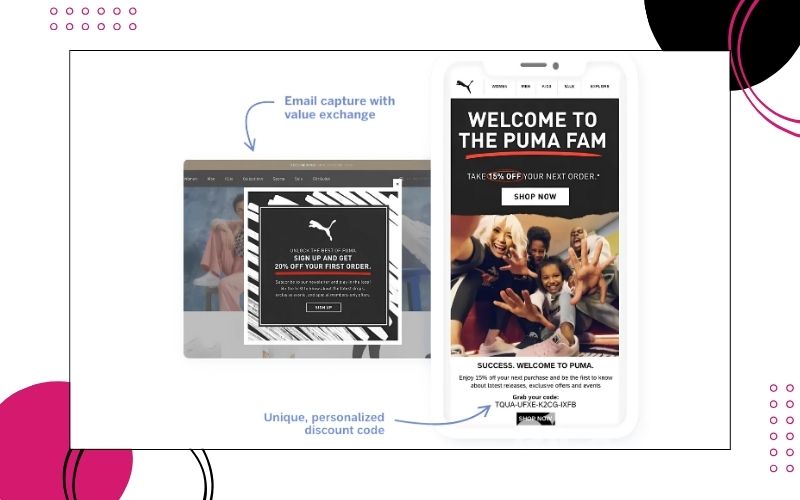
It is no longer enough to have a strong presence on just one channel, to stay competitive, you need to engage with your audience wherever they are, in a way that feels connected and consistent.
To succeed with omnichannel marketing, you will need to:
- Integrate your marketing tools to ensure smooth data flow across channels.
- Create cohesive campaigns that offer a consistent experience.
- Use personalised messaging based on how your audience behaves on different channels.
- Focus on mobile-first strategies.
First-Party Data Collection
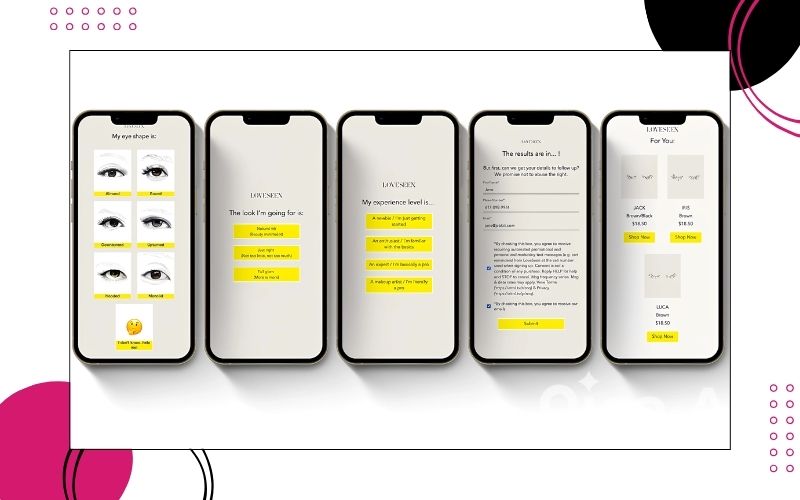
With Google’s decision to extend support for third-party cookies until 2025, businesses are already acting to future-proof their marketing strategies by prioritising first-party data collection.
First-party data, the information businesses collect directly from their audience, such as through surveys, on-site registrations, or customer purchase history, will be essential for building more personalised and targeted campaigns.
In 2025, businesses should focus on collecting and leveraging first-party data through methods like:
- Running customer surveys and feedback loops
- Reviewing details from user registrations and memberships
- Implementing event-based tracking for better targeting
- Analysing customer purchase history for deeper insights
Short-Form Video Dominance

Video content has long been a powerhouse in content marketing, but in 2025, short-form video will be the dominant format. 87.5% of internet users aged 16 to 64 spend a significant amount of time watching video content.
In 2025, Australian brands will continue embracing video content platforms like TikTok, Instagram Reels, and YouTube Shorts to drive engagement, increase brand awareness, and communicate messages quickly and effectively.
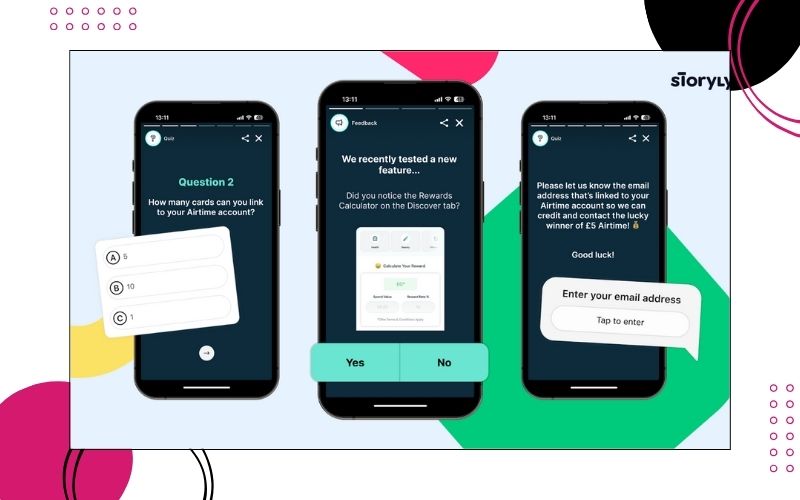
Consumers crave more interaction and personalised experiences. Static content is losing its appeal, and interactive content is quickly becoming the norm. Think quizzes, polls, interactive videos, and augmented reality (AR) experiences that allow users to engage with your brand on a deeper level.
Social Commerce Integration

Social commerce is here to stay, and it is only getting bigger. In 2025, brands will need to seamlessly integrate shopping experiences into their social media strategies. Instagram, Facebook, TikTok, and even Pinterest are making it easier than ever for users to shop directly from their feeds.
If you haven’t already, start integrating e-commerce functionality into your social media channels. Don’t just post product images; create compelling content that inspires action, like exclusive sales, product launches, or limited-time offers.
Prepare for 2025: Stay Ahead of the Content Marketing Trends
With new content marketing trends continuously reshaping the digital world, keeping your brand relevant means staying on top of the latest developments. The challenge of managing these trends doesn’t have to be overwhelming. Don't let your strategy fall behind – it is time to plan for the future and set your brand up for success
Get in touch with us today, and let’s start preparing your business for the content marketing trends that will define 2025. Our team of experts is here to help you build a proactive, tailored strategy that positions your brand for success. The time to act is now—don’t let another year pass by without setting your business up for growth and innovation.

The world of content marketing is a bit like navigating a bustling city. Every corner brings a new trend, and just when you think you have mastered the fastest route, a detour shakes up your plans. In 2025, the landscape is evolving faster than ever, with artificial intelligence taking the wheel, audiences demanding authenticity over perfection, and personalisation becoming the currency of connection. These are not just passing fads, they are the direction-setters for how brands will captivate, engage, and retain their audiences, all of which point to the emerging content marketing trends shaping the year ahead.
If you are ready to stay ahead of the curve, this guide will equip you with the knowledge to thrive. We will explore the top content marketing trends driving the industry forward. Stay with us and discover the insights that can transform your strategy and ensure your brand is not just part of the conversation but leading it.
What’s Inside:
- Understanding Content Marketing
- Content Marketing in Australia 2024
- Top Content Marketing Trends for 2025
- Prepare for 2025: Stay Ahead of the Content Marketing Trends
Understanding Content Marketing
In an era dominated by information overload, people want content that is authentic, insightful, and helpful. Traditional advertising methods are becoming less effective, with consumers actively avoiding interruptions.
Content marketing, however, provides an opportunity to connect meaningfully with audiences by offering value, educating, or entertaining them. It nurtures long-term relationships, builds brand authority, and drives organic growth, making it a cornerstone of modern marketing strategies. That’s why content marketing is important in the field of digital marketing.
Content Marketing in Australia 2024
The content marketing industry in Australia continues to demonstrate strong growth, with a market size of $453.2 million. Over the past five years, the sector has expanded at a compound annual growth rate (CAGR) of 4.3%, reflecting the increasing importance of content-driven strategies in businesses across the country.
This trend is further evidenced by the rise in the number of content marketing businesses, which have grown at a robust CAGR of 9.2%. The Australian market is clearly embracing the shift towards more engaging and informative digital marketing, with brands investing in content creation, SEO, and social media to better connect with their audiences.
Source: ibisworld.com
Top Content Marketing Trends for 2025

As we move closer to 2025, businesses are gearing up to stay ahead of the curve in content marketing. Here are the key content marketing trends that will define the next year, and what you need to do to leverage them for success:
AI-Powered Content Creation

AI is no longer just a buzzword, it is a central pillar in content marketing. As of 2024, 67% of small businesses worldwide have integrated AI into their SEO strategies for businesses. This adoption is not just a passing trend, 68% of those leveraging AI have seen marked improvements in content marketing ROI, with nearly all (99%) using a mix of tools to optimise both SEO and content creation.
In 2025, AI’s role in content marketing will continue to grow, enabling businesses to produce high-quality, personalised content at scale. AI-driven tools will help marketers identify trending topics, optimise content for SEO, and even create customised content based on audience preferences.
Hyper-personalisation

As we head into 2025, one thing is clear, hyperpersonalisation is no longer a trend, it is a necessity. The days of relying on generic, one-size-fits-all messaging are officially over. If you are still sending out the same content to your entire audience, it is time to rethink your strategy. The shift towards personalisation is undeniable, and the demand for tailored experiences is higher than ever.
Omnichannel Marketing

It is no longer enough to have a strong presence on just one channel, to stay competitive, you need to engage with your audience wherever they are, in a way that feels connected and consistent.
To succeed with omnichannel marketing, you will need to:
- Integrate your marketing tools to ensure smooth data flow across channels.
- Create cohesive campaigns that offer a consistent experience.
- Use personalised messaging based on how your audience behaves on different channels.
- Focus on mobile-first strategies.
First-Party Data Collection

With Google’s decision to extend support for third-party cookies until 2025, businesses are already acting to future-proof their marketing strategies by prioritising first-party data collection.
First-party data, the information businesses collect directly from their audience, such as through surveys, on-site registrations, or customer purchase history, will be essential for building more personalised and targeted campaigns.
In 2025, businesses should focus on collecting and leveraging first-party data through methods like:
- Running customer surveys and feedback loops
- Reviewing details from user registrations and memberships
- Implementing event-based tracking for better targeting
- Analysing customer purchase history for deeper insights
Short-Form Video Dominance

Video content has long been a powerhouse in content marketing, but in 2025, short-form video will be the dominant format. 87.5% of internet users aged 16 to 64 spend a significant amount of time watching video content.
In 2025, Australian brands will continue embracing video content platforms like TikTok, Instagram Reels, and YouTube Shorts to drive engagement, increase brand awareness, and communicate messages quickly and effectively.

Consumers crave more interaction and personalised experiences. Static content is losing its appeal, and interactive content is quickly becoming the norm. Think quizzes, polls, interactive videos, and augmented reality (AR) experiences that allow users to engage with your brand on a deeper level.
Social Commerce Integration

Social commerce is here to stay, and it is only getting bigger. In 2025, brands will need to seamlessly integrate shopping experiences into their social media strategies. Instagram, Facebook, TikTok, and even Pinterest are making it easier than ever for users to shop directly from their feeds.
If you haven’t already, start integrating e-commerce functionality into your social media channels. Don’t just post product images; create compelling content that inspires action, like exclusive sales, product launches, or limited-time offers.
Prepare for 2025: Stay Ahead of the Content Marketing Trends
With new content marketing trends continuously reshaping the digital world, keeping your brand relevant means staying on top of the latest developments. The challenge of managing these trends doesn’t have to be overwhelming. Don't let your strategy fall behind – it is time to plan for the future and set your brand up for success
Get in touch with us today, and let’s start preparing your business for the content marketing trends that will define 2025. Our team of experts is here to help you build a proactive, tailored strategy that positions your brand for success. The time to act is now—don’t let another year pass by without setting your business up for growth and innovation.
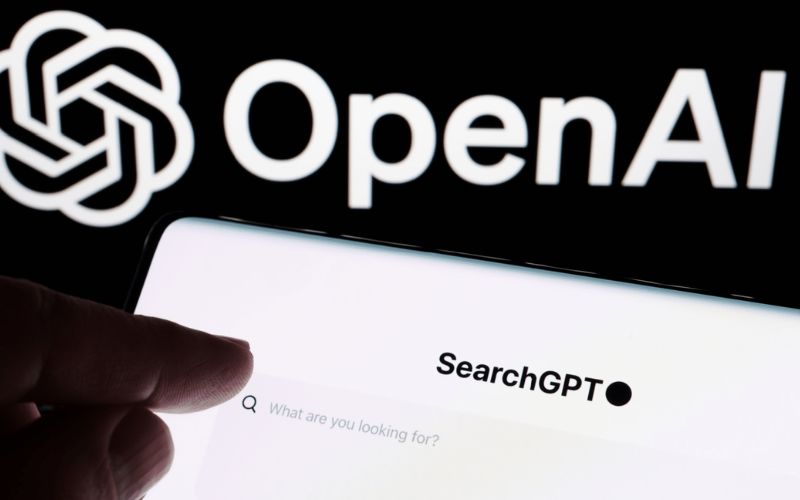
Last 25th July, OpenAI announced the SearchGPT search engine, a new AI search prototype that shifts the paradigm from keyword-based search to conversational search. This innovative model aims to offer a more intuitive and contextually aware search experience.
But as SearchGPT steps onto the stage, intriguing questions linger in the air. Can SearchGPT truly outshine other search engines? Will it truly respect the integrity of journalism and publishers? And most importantly, can it stay away from the mistakes that other AI attempts have made?
Let’s discover if SearchGPT is the next big thing or merely a fleeting trend. Learn about SearchGPT's features and potential, and how they can be optimised for brand visibility. Explore how this new tool could be used for enhanced engagement and growth in the digital landscape.
What’s Inside:
- SearchGPT Search Engine Overview
- Key Features of the SearchGPT Search Engine
- Comparing SearchGPT with Other AI-Search Platforms
- Enhancing eCommerce and Business Growth with SearchGPT
- Optimising Your Visibility with SearchGPT Search Engine
- Be Ready for the Future of Search with SearchGPT!
SearchGPT Search Engine Overview
What is SearchGPT Search Engine?
SearchGPT search engine is an advanced platform that combines cutting-edge technologies like natural language processing (NLP), machine learning algorithms, and large datasets to deliver precise and contextually appropriate search results. It moves beyond simple keyword matching, aiming to understand the context of user queries to generate human-like responses rather than just a list of links.
How Does SearchGPT Search Engine Work?

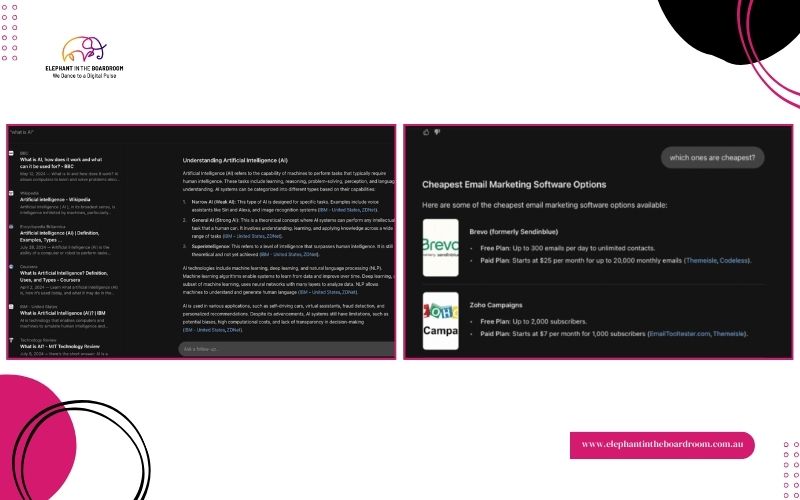
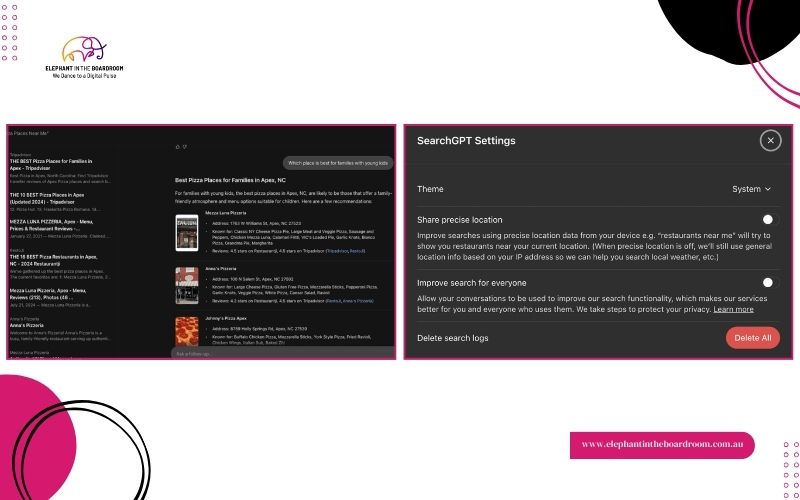
SearchGPT works through a multi-step process that begins with Natural Language Processing (NLP) to interpret and break down the user’s query, identifying its intent and context. It then uses contextual understanding to differentiate between similar terms and nuances.
To find the most relevant details, the engine interprets through a variety of data sources, such as text documents, web pages, and structured databases. To improve its efficiency over time, it continuously learns from fresh data and user interactions and concludes in the generation of a thorough response specifically customised to the study.
Key Features of the SearchGPT Search Engine
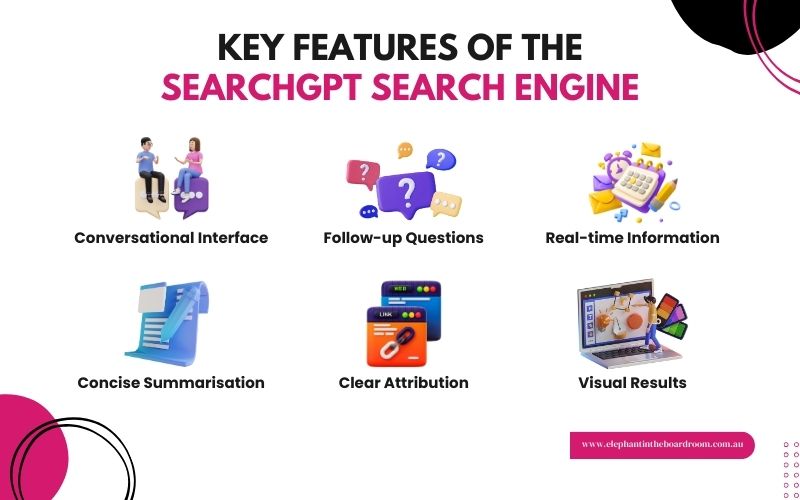
SearchGPT offers a comprehensive set of features designed to enhance the search experience and provide users with more accurate and informative results. The following are the key features of SearchGPT:
Conversational Interface
SearchGPT provides a natural language interface, allowing users to ask questions in a conversational manner, similar to interacting with a human.
Follow-up Questions
Users can ask follow-up questions to delve deeper into a topic, creating a more interactive and engaging search experience.
Real-time Information
SearchGPT leverages real-time data from the web to deliver up-to-date information, ensuring that users always have access to the most current knowledge.
Concise Summaries
Instead of simply listing links, SearchGPT provides concise summaries of relevant information, saving users time and effort.
Clear Attribution
SearchGPT includes clear attributions and source links, allowing users to verify the information and explore further details on the original websites.
Visual Results
To provide a richer understanding, SearchGPT offers visual results in the form of images and videos, making it easier to comprehend complex information.
Comparing SearchGPT with Other Search Engines
Perplexity AI, with 67.42 million total visits, and ChatGPT, attracting 260.2 million monthly visitors, demonstrate the growing demand for AI-powered information retrieval. As SearchGPT enters the scene, SearchGPT needs to make a name for itself amid these well-established competitors by providing standout benefits.
SearchGPT vs. Google
SearchGPT offers a more conversational and interactive search experience compared to Google. Unlike Google's traditional keyword-based approach that provides a list of links, SearchGPT uses natural language processing to deliver direct answers, cite sources, and understand the intent behind queries, even if they are complex or ambiguous.
It maintains context across multiple interactions, creating a dynamic, personalised search experience. Additionally, SearchGPT focuses on providing real-time, accurate information, whereas Google's results, while comprehensive, may sometimes include outdated or irrelevant content.
SearchGPT vs. AI Overviews
SearchGPT and AI Overviews both use AI to summarise information and provide direct answers. Both tools deliver direct answers to user queries, aiming to save time by presenting condensed overviews rather than just a list of links.
However, SearchGPT focuses more on in-depth research and transparent sourcing, making it suitable for users seeking comprehensive insights, while AI Overviews are made for those who need quick summaries and introductory content. Both platforms are in active development, and their features and functionalities may evolve and converge over time.
SearchGPT vs. ChatGPT
SearchGPT and ChatGPT, both developed by OpenAI, share a conversational interface and foundation in advanced language models. However, SearchGPT is designed for real-time search queries with clear source attributions, while ChatGPT focuses on generating human-like conversational responses.
SearchGPT vs. Perplexity
SearchGPT and Perplexity are AI-driven search engines with conversational interfaces that refine search processes. While both enhance user interactions, SearchGPT excels in providing quick answers and real-time information, making it ideal for immediate needs. In contrast, Perplexity focuses on in-depth research, offering access to scholarly sources and a feature-rich interface for comprehensive investigations.
Enhancing eCommerce and Business Growth with SearchGPT
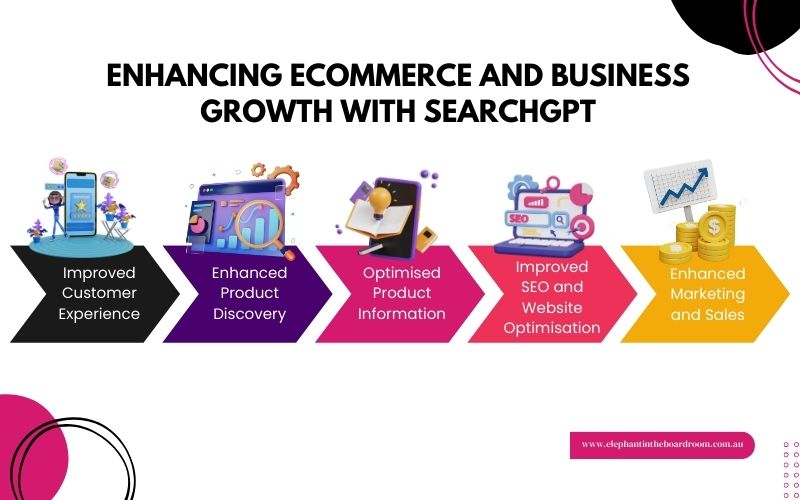
SearchGPT, with its advanced AI capabilities and conversational interface, offers significant potential to revolutionise eCommerce and drive business growth. By providing a more intuitive and engaging search experience, SearchGPT can enhance customer satisfaction, increase conversions, and ultimately boost revenue.
Here are some key ways in which SearchGPT can be used to enhance eCommerce platforms and business growth:
Improved Customer Experience
- Personalised search- SearchGPT can provide highly personalised search results based on individual customer preferences, browsing history, and purchase behaviour.
- Conversational support- By integrating SearchGPT into customer support channels, businesses can offer 24/7 assistance, addressing customer queries and concerns in a timely and efficient manner.
Enhanced Product Discovery
- Semantic search- SearchGPT's understanding of natural language allows it to comprehend complex search queries, leading to more accurate and relevant product suggestions.
- Visual search- By enabling visual search capabilities, SearchGPT can help customers find products based on images, making the shopping experience more intuitive.
Optimised Product Information
- Automatic content generation- SearchGPT can be used to generate product descriptions, meta tags, and other content, ensuring that product information is accurate, engaging, and optimised for search engines.
Improved SEO and Website Optimisation
- Keyword Research- SearchGPT can assist in identifying relevant keywords and phrases for SEO & digital marketing, helping businesses optimise their website content for search engines.
- On-Page Optimisation- By suggesting improvements to on-page elements such as titles, meta descriptions, and header tags, SearchGPT can contribute to better search engine rankings.
Enhanced Marketing and Sales
- Targeted marketing campaigns- SearchGPT can help businesses create targeted marketing campaigns based on customer preferences, demographics, and purchase history.
- Sales lead generation- By analysing customer behaviour and identifying potential leads, SearchGPT can contribute to increased sales and revenue.
Optimising Your Visibility with SearchGPT Search Engine
Staying visible and relevant online is important for businesses and individuals alike. With the emergence of AI-powered search engines like SearchGPT, new opportunities for enhanced visibility and engagement are emerging.
Here are the ways how you can optimise your visibility using SearchGPT:
Use Real-Time Information
Utilise SearchGPT’s ability to access and provide up-to-date information to ensure your content remains relevant and timely.
Enhance Transparency
Take advantage of SearchGPT’s clear source attribution to build trust with your audience by linking directly to credible and authoritative sources.
Utilise Conversational Interface
Engage with users through SearchGPT’s natural language capabilities, allowing for more personalised and interactive experiences.
Focus on Summarisation
Benefit from concise summaries that make your content easily digestible and more likely to be featured prominently in search results.
Incorporate Visual Results
Use visual elements such as images and videos to attract attention and enhance user engagement in search results.
Monitor Performance
Track how your content is performing with SearchGPT to refine your strategies and improve visibility based on real-time data insights for the data analysis.
Be Ready for the Future of Search with SearchGPT
The future of search is rapidly evolving, and SearchGPT is leading the way with innovative AI-driven technology. By offering more intuitive, conversational, and context-rich results, it’s transforming how users find information.
As businesses and individuals alike prepare for this shift, staying ahead of the curve with SearchGPT can unlock new opportunities for discovery, engagement, and efficiency.
This presents an opportunity for your business to optimise your visibility and drive growth as SearchGPT sets new standards in search innovation. Keep an eye out for updates and learn more about how you can benefit from its cutting-edge features.
Talk with us today to explore how we can help you integrate SearchGPT into your strategy and maximise your digital impact. Let’s lead the future of search together—your competitive advantage starts here.

Last 25th July, OpenAI announced the SearchGPT search engine, a new AI search prototype that shifts the paradigm from keyword-based search to conversational search. This innovative model aims to offer a more intuitive and contextually aware search experience.
But as SearchGPT steps onto the stage, intriguing questions linger in the air. Can SearchGPT truly outshine other search engines? Will it truly respect the integrity of journalism and publishers? And most importantly, can it stay away from the mistakes that other AI attempts have made?
Let’s discover if SearchGPT is the next big thing or merely a fleeting trend. Learn about SearchGPT's features and potential, and how they can be optimised for brand visibility. Explore how this new tool could be used for enhanced engagement and growth in the digital landscape.
What’s Inside:
- SearchGPT Search Engine Overview
- Key Features of the SearchGPT Search Engine
- Comparing SearchGPT with Other AI-Search Platforms
- Enhancing eCommerce and Business Growth with SearchGPT
- Optimising Your Visibility with SearchGPT Search Engine
- Be Ready for the Future of Search with SearchGPT!
SearchGPT Search Engine Overview
What is SearchGPT Search Engine?
SearchGPT search engine is an advanced platform that combines cutting-edge technologies like natural language processing (NLP), machine learning algorithms, and large datasets to deliver precise and contextually appropriate search results. It moves beyond simple keyword matching, aiming to understand the context of user queries to generate human-like responses rather than just a list of links.
How Does SearchGPT Search Engine Work?



SearchGPT works through a multi-step process that begins with Natural Language Processing (NLP) to interpret and break down the user’s query, identifying its intent and context. It then uses contextual understanding to differentiate between similar terms and nuances.
To find the most relevant details, the engine interprets through a variety of data sources, such as text documents, web pages, and structured databases. To improve its efficiency over time, it continuously learns from fresh data and user interactions and concludes in the generation of a thorough response specifically customised to the study.
Key Features of the SearchGPT Search Engine

SearchGPT offers a comprehensive set of features designed to enhance the search experience and provide users with more accurate and informative results. The following are the key features of SearchGPT:
Conversational Interface
SearchGPT provides a natural language interface, allowing users to ask questions in a conversational manner, similar to interacting with a human.
Follow-up Questions
Users can ask follow-up questions to delve deeper into a topic, creating a more interactive and engaging search experience.
Real-time Information
SearchGPT leverages real-time data from the web to deliver up-to-date information, ensuring that users always have access to the most current knowledge.
Concise Summaries
Instead of simply listing links, SearchGPT provides concise summaries of relevant information, saving users time and effort.
Clear Attribution
SearchGPT includes clear attributions and source links, allowing users to verify the information and explore further details on the original websites.
Visual Results
To provide a richer understanding, SearchGPT offers visual results in the form of images and videos, making it easier to comprehend complex information.
Comparing SearchGPT with Other Search Engines
Perplexity AI, with 67.42 million total visits, and ChatGPT, attracting 260.2 million monthly visitors, demonstrate the growing demand for AI-powered information retrieval. As SearchGPT enters the scene, SearchGPT needs to make a name for itself amid these well-established competitors by providing standout benefits.
SearchGPT vs. Google
SearchGPT offers a more conversational and interactive search experience compared to Google. Unlike Google's traditional keyword-based approach that provides a list of links, SearchGPT uses natural language processing to deliver direct answers, cite sources, and understand the intent behind queries, even if they are complex or ambiguous.
It maintains context across multiple interactions, creating a dynamic, personalised search experience. Additionally, SearchGPT focuses on providing real-time, accurate information, whereas Google's results, while comprehensive, may sometimes include outdated or irrelevant content.
SearchGPT vs. AI Overviews
SearchGPT and AI Overviews both use AI to summarise information and provide direct answers. Both tools deliver direct answers to user queries, aiming to save time by presenting condensed overviews rather than just a list of links.
However, SearchGPT focuses more on in-depth research and transparent sourcing, making it suitable for users seeking comprehensive insights, while AI Overviews are made for those who need quick summaries and introductory content. Both platforms are in active development, and their features and functionalities may evolve and converge over time.
SearchGPT vs. ChatGPT
SearchGPT and ChatGPT, both developed by OpenAI, share a conversational interface and foundation in advanced language models. However, SearchGPT is designed for real-time search queries with clear source attributions, while ChatGPT focuses on generating human-like conversational responses.
SearchGPT vs. Perplexity
SearchGPT and Perplexity are AI-driven search engines with conversational interfaces that refine search processes. While both enhance user interactions, SearchGPT excels in providing quick answers and real-time information, making it ideal for immediate needs. In contrast, Perplexity focuses on in-depth research, offering access to scholarly sources and a feature-rich interface for comprehensive investigations.
Enhancing eCommerce and Business Growth with SearchGPT

SearchGPT, with its advanced AI capabilities and conversational interface, offers significant potential to revolutionise eCommerce and drive business growth. By providing a more intuitive and engaging search experience, SearchGPT can enhance customer satisfaction, increase conversions, and ultimately boost revenue.
Here are some key ways in which SearchGPT can be used to enhance eCommerce platforms and business growth:
Improved Customer Experience
- Personalised search- SearchGPT can provide highly personalised search results based on individual customer preferences, browsing history, and purchase behaviour.
- Conversational support- By integrating SearchGPT into customer support channels, businesses can offer 24/7 assistance, addressing customer queries and concerns in a timely and efficient manner.
Enhanced Product Discovery
- Semantic search- SearchGPT's understanding of natural language allows it to comprehend complex search queries, leading to more accurate and relevant product suggestions.
- Visual search- By enabling visual search capabilities, SearchGPT can help customers find products based on images, making the shopping experience more intuitive.
Optimised Product Information
- Automatic content generation- SearchGPT can be used to generate product descriptions, meta tags, and other content, ensuring that product information is accurate, engaging, and optimised for search engines.
Improved SEO and Website Optimisation
- Keyword Research- SearchGPT can assist in identifying relevant keywords and phrases for SEO & digital marketing, helping businesses optimise their website content for search engines.
- On-Page Optimisation- By suggesting improvements to on-page elements such as titles, meta descriptions, and header tags, SearchGPT can contribute to better search engine rankings.
Enhanced Marketing and Sales
- Targeted marketing campaigns- SearchGPT can help businesses create targeted marketing campaigns based on customer preferences, demographics, and purchase history.
- Sales lead generation- By analysing customer behaviour and identifying potential leads, SearchGPT can contribute to increased sales and revenue.
Optimising Your Visibility with SearchGPT Search Engine
Staying visible and relevant online is important for businesses and individuals alike. With the emergence of AI-powered search engines like SearchGPT, new opportunities for enhanced visibility and engagement are emerging.
Here are the ways how you can optimise your visibility using SearchGPT:
Use Real-Time Information
Utilise SearchGPT’s ability to access and provide up-to-date information to ensure your content remains relevant and timely.
Enhance Transparency
Take advantage of SearchGPT’s clear source attribution to build trust with your audience by linking directly to credible and authoritative sources.
Utilise Conversational Interface
Engage with users through SearchGPT’s natural language capabilities, allowing for more personalised and interactive experiences.
Focus on Summarisation
Benefit from concise summaries that make your content easily digestible and more likely to be featured prominently in search results.
Incorporate Visual Results
Use visual elements such as images and videos to attract attention and enhance user engagement in search results.
Monitor Performance
Track how your content is performing with SearchGPT to refine your strategies and improve visibility based on real-time data insights for the data analysis.
Be Ready for the Future of Search with SearchGPT
The future of search is rapidly evolving, and SearchGPT is leading the way with innovative AI-driven technology. By offering more intuitive, conversational, and context-rich results, it’s transforming how users find information.
As businesses and individuals alike prepare for this shift, staying ahead of the curve with SearchGPT can unlock new opportunities for discovery, engagement, and efficiency.
This presents an opportunity for your business to optimise your visibility and drive growth as SearchGPT sets new standards in search innovation. Keep an eye out for updates and learn more about how you can benefit from its cutting-edge features.
Talk with us today to explore how we can help you integrate SearchGPT into your strategy and maximise your digital impact. Let’s lead the future of search together—your competitive advantage starts here.

Last 25th July, OpenAI announced the SearchGPT search engine, a new AI search prototype that shifts the paradigm from keyword-based search to conversational search. This innovative model aims to offer a more intuitive and contextually aware search experience.
But as SearchGPT steps onto the stage, intriguing questions linger in the air. Can SearchGPT truly outshine other search engines? Will it truly respect the integrity of journalism and publishers? And most importantly, can it stay away from the mistakes that other AI attempts have made?
Let’s discover if SearchGPT is the next big thing or merely a fleeting trend. Learn about SearchGPT's features and potential, and how they can be optimised for brand visibility. Explore how this new tool could be used for enhanced engagement and growth in the digital landscape.
What’s Inside:
- SearchGPT Search Engine Overview
- Key Features of the SearchGPT Search Engine
- Comparing SearchGPT with Other AI-Search Platforms
- Enhancing eCommerce and Business Growth with SearchGPT
- Optimising Your Visibility with SearchGPT Search Engine
- Be Ready for the Future of Search with SearchGPT!
SearchGPT Search Engine Overview
What is SearchGPT Search Engine?
SearchGPT search engine is an advanced platform that combines cutting-edge technologies like natural language processing (NLP), machine learning algorithms, and large datasets to deliver precise and contextually appropriate search results. It moves beyond simple keyword matching, aiming to understand the context of user queries to generate human-like responses rather than just a list of links.
How Does SearchGPT Search Engine Work?



SearchGPT works through a multi-step process that begins with Natural Language Processing (NLP) to interpret and break down the user’s query, identifying its intent and context. It then uses contextual understanding to differentiate between similar terms and nuances.
To find the most relevant details, the engine interprets through a variety of data sources, such as text documents, web pages, and structured databases. To improve its efficiency over time, it continuously learns from fresh data and user interactions and concludes in the generation of a thorough response specifically customised to the study.
Key Features of the SearchGPT Search Engine

SearchGPT offers a comprehensive set of features designed to enhance the search experience and provide users with more accurate and informative results. The following are the key features of SearchGPT:
Conversational Interface
SearchGPT provides a natural language interface, allowing users to ask questions in a conversational manner, similar to interacting with a human.
Follow-up Questions
Users can ask follow-up questions to delve deeper into a topic, creating a more interactive and engaging search experience.
Real-time Information
SearchGPT leverages real-time data from the web to deliver up-to-date information, ensuring that users always have access to the most current knowledge.
Concise Summaries
Instead of simply listing links, SearchGPT provides concise summaries of relevant information, saving users time and effort.
Clear Attribution
SearchGPT includes clear attributions and source links, allowing users to verify the information and explore further details on the original websites.
Visual Results
To provide a richer understanding, SearchGPT offers visual results in the form of images and videos, making it easier to comprehend complex information.
Comparing SearchGPT with Other Search Engines
Perplexity AI, with 67.42 million total visits, and ChatGPT, attracting 260.2 million monthly visitors, demonstrate the growing demand for AI-powered information retrieval. As SearchGPT enters the scene, SearchGPT needs to make a name for itself amid these well-established competitors by providing standout benefits.
SearchGPT vs. Google
SearchGPT offers a more conversational and interactive search experience compared to Google. Unlike Google's traditional keyword-based approach that provides a list of links, SearchGPT uses natural language processing to deliver direct answers, cite sources, and understand the intent behind queries, even if they are complex or ambiguous.
It maintains context across multiple interactions, creating a dynamic, personalised search experience. Additionally, SearchGPT focuses on providing real-time, accurate information, whereas Google's results, while comprehensive, may sometimes include outdated or irrelevant content.
SearchGPT vs. AI Overviews
SearchGPT and AI Overviews both use AI to summarise information and provide direct answers. Both tools deliver direct answers to user queries, aiming to save time by presenting condensed overviews rather than just a list of links.
However, SearchGPT focuses more on in-depth research and transparent sourcing, making it suitable for users seeking comprehensive insights, while AI Overviews are made for those who need quick summaries and introductory content. Both platforms are in active development, and their features and functionalities may evolve and converge over time.
SearchGPT vs. ChatGPT
SearchGPT and ChatGPT, both developed by OpenAI, share a conversational interface and foundation in advanced language models. However, SearchGPT is designed for real-time search queries with clear source attributions, while ChatGPT focuses on generating human-like conversational responses.
SearchGPT vs. Perplexity
SearchGPT and Perplexity are AI-driven search engines with conversational interfaces that refine search processes. While both enhance user interactions, SearchGPT excels in providing quick answers and real-time information, making it ideal for immediate needs. In contrast, Perplexity focuses on in-depth research, offering access to scholarly sources and a feature-rich interface for comprehensive investigations.
Enhancing eCommerce and Business Growth with SearchGPT

SearchGPT, with its advanced AI capabilities and conversational interface, offers significant potential to revolutionise eCommerce and drive business growth. By providing a more intuitive and engaging search experience, SearchGPT can enhance customer satisfaction, increase conversions, and ultimately boost revenue.
Here are some key ways in which SearchGPT can be used to enhance eCommerce platforms and business growth:
Improved Customer Experience
- Personalised search- SearchGPT can provide highly personalised search results based on individual customer preferences, browsing history, and purchase behaviour.
- Conversational support- By integrating SearchGPT into customer support channels, businesses can offer 24/7 assistance, addressing customer queries and concerns in a timely and efficient manner.
Enhanced Product Discovery
- Semantic search- SearchGPT's understanding of natural language allows it to comprehend complex search queries, leading to more accurate and relevant product suggestions.
- Visual search- By enabling visual search capabilities, SearchGPT can help customers find products based on images, making the shopping experience more intuitive.
Optimised Product Information
- Automatic content generation- SearchGPT can be used to generate product descriptions, meta tags, and other content, ensuring that product information is accurate, engaging, and optimised for search engines.
Improved SEO and Website Optimisation
- Keyword Research- SearchGPT can assist in identifying relevant keywords and phrases for SEO & digital marketing, helping businesses optimise their website content for search engines.
- On-Page Optimisation- By suggesting improvements to on-page elements such as titles, meta descriptions, and header tags, SearchGPT can contribute to better search engine rankings.
Enhanced Marketing and Sales
- Targeted marketing campaigns- SearchGPT can help businesses create targeted marketing campaigns based on customer preferences, demographics, and purchase history.
- Sales lead generation- By analysing customer behaviour and identifying potential leads, SearchGPT can contribute to increased sales and revenue.
Optimising Your Visibility with SearchGPT Search Engine
Staying visible and relevant online is important for businesses and individuals alike. With the emergence of AI-powered search engines like SearchGPT, new opportunities for enhanced visibility and engagement are emerging.
Here are the ways how you can optimise your visibility using SearchGPT:
Use Real-Time Information
Utilise SearchGPT’s ability to access and provide up-to-date information to ensure your content remains relevant and timely.
Enhance Transparency
Take advantage of SearchGPT’s clear source attribution to build trust with your audience by linking directly to credible and authoritative sources.
Utilise Conversational Interface
Engage with users through SearchGPT’s natural language capabilities, allowing for more personalised and interactive experiences.
Focus on Summarisation
Benefit from concise summaries that make your content easily digestible and more likely to be featured prominently in search results.
Incorporate Visual Results
Use visual elements such as images and videos to attract attention and enhance user engagement in search results.
Monitor Performance
Track how your content is performing with SearchGPT to refine your strategies and improve visibility based on real-time data insights for the data analysis.
Be Ready for the Future of Search with SearchGPT
The future of search is rapidly evolving, and SearchGPT is leading the way with innovative AI-driven technology. By offering more intuitive, conversational, and context-rich results, it’s transforming how users find information.
As businesses and individuals alike prepare for this shift, staying ahead of the curve with SearchGPT can unlock new opportunities for discovery, engagement, and efficiency.
This presents an opportunity for your business to optimise your visibility and drive growth as SearchGPT sets new standards in search innovation. Keep an eye out for updates and learn more about how you can benefit from its cutting-edge features.
Talk with us today to explore how we can help you integrate SearchGPT into your strategy and maximise your digital impact. Let’s lead the future of search together—your competitive advantage starts here.

Last 25th July, OpenAI announced the SearchGPT search engine, a new AI search prototype that shifts the paradigm from keyword-based search to conversational search. This innovative model aims to offer a more intuitive and contextually aware search experience.
But as SearchGPT steps onto the stage, intriguing questions linger in the air. Can SearchGPT truly outshine other search engines? Will it truly respect the integrity of journalism and publishers? And most importantly, can it stay away from the mistakes that other AI attempts have made?
Let’s discover if SearchGPT is the next big thing or merely a fleeting trend. Learn about SearchGPT's features and potential, and how they can be optimised for brand visibility. Explore how this new tool could be used for enhanced engagement and growth in the digital landscape.
What’s Inside:
- SearchGPT Search Engine Overview
- Key Features of the SearchGPT Search Engine
- Comparing SearchGPT with Other AI-Search Platforms
- Enhancing eCommerce and Business Growth with SearchGPT
- Optimising Your Visibility with SearchGPT Search Engine
- Be Ready for the Future of Search with SearchGPT!
SearchGPT Search Engine Overview
What is SearchGPT Search Engine?
SearchGPT search engine is an advanced platform that combines cutting-edge technologies like natural language processing (NLP), machine learning algorithms, and large datasets to deliver precise and contextually appropriate search results. It moves beyond simple keyword matching, aiming to understand the context of user queries to generate human-like responses rather than just a list of links.
How Does SearchGPT Search Engine Work?



SearchGPT works through a multi-step process that begins with Natural Language Processing (NLP) to interpret and break down the user’s query, identifying its intent and context. It then uses contextual understanding to differentiate between similar terms and nuances.
To find the most relevant details, the engine interprets through a variety of data sources, such as text documents, web pages, and structured databases. To improve its efficiency over time, it continuously learns from fresh data and user interactions and concludes in the generation of a thorough response specifically customised to the study.
Key Features of the SearchGPT Search Engine

SearchGPT offers a comprehensive set of features designed to enhance the search experience and provide users with more accurate and informative results. The following are the key features of SearchGPT:
Conversational Interface
SearchGPT provides a natural language interface, allowing users to ask questions in a conversational manner, similar to interacting with a human.
Follow-up Questions
Users can ask follow-up questions to delve deeper into a topic, creating a more interactive and engaging search experience.
Real-time Information
SearchGPT leverages real-time data from the web to deliver up-to-date information, ensuring that users always have access to the most current knowledge.
Concise Summaries
Instead of simply listing links, SearchGPT provides concise summaries of relevant information, saving users time and effort.
Clear Attribution
SearchGPT includes clear attributions and source links, allowing users to verify the information and explore further details on the original websites.
Visual Results
To provide a richer understanding, SearchGPT offers visual results in the form of images and videos, making it easier to comprehend complex information.
Comparing SearchGPT with Other Search Engines
Perplexity AI, with 67.42 million total visits, and ChatGPT, attracting 260.2 million monthly visitors, demonstrate the growing demand for AI-powered information retrieval. As SearchGPT enters the scene, SearchGPT needs to make a name for itself amid these well-established competitors by providing standout benefits.
SearchGPT vs. Google
SearchGPT offers a more conversational and interactive search experience compared to Google. Unlike Google's traditional keyword-based approach that provides a list of links, SearchGPT uses natural language processing to deliver direct answers, cite sources, and understand the intent behind queries, even if they are complex or ambiguous.
It maintains context across multiple interactions, creating a dynamic, personalised search experience. Additionally, SearchGPT focuses on providing real-time, accurate information, whereas Google's results, while comprehensive, may sometimes include outdated or irrelevant content.
SearchGPT vs. AI Overviews
SearchGPT and AI Overviews both use AI to summarise information and provide direct answers. Both tools deliver direct answers to user queries, aiming to save time by presenting condensed overviews rather than just a list of links.
However, SearchGPT focuses more on in-depth research and transparent sourcing, making it suitable for users seeking comprehensive insights, while AI Overviews are made for those who need quick summaries and introductory content. Both platforms are in active development, and their features and functionalities may evolve and converge over time.
SearchGPT vs. ChatGPT
SearchGPT and ChatGPT, both developed by OpenAI, share a conversational interface and foundation in advanced language models. However, SearchGPT is designed for real-time search queries with clear source attributions, while ChatGPT focuses on generating human-like conversational responses.
SearchGPT vs. Perplexity
SearchGPT and Perplexity are AI-driven search engines with conversational interfaces that refine search processes. While both enhance user interactions, SearchGPT excels in providing quick answers and real-time information, making it ideal for immediate needs. In contrast, Perplexity focuses on in-depth research, offering access to scholarly sources and a feature-rich interface for comprehensive investigations.
Enhancing eCommerce and Business Growth with SearchGPT

SearchGPT, with its advanced AI capabilities and conversational interface, offers significant potential to revolutionise eCommerce and drive business growth. By providing a more intuitive and engaging search experience, SearchGPT can enhance customer satisfaction, increase conversions, and ultimately boost revenue.
Here are some key ways in which SearchGPT can be used to enhance eCommerce platforms and business growth:
Improved Customer Experience
- Personalised search- SearchGPT can provide highly personalised search results based on individual customer preferences, browsing history, and purchase behaviour.
- Conversational support- By integrating SearchGPT into customer support channels, businesses can offer 24/7 assistance, addressing customer queries and concerns in a timely and efficient manner.
Enhanced Product Discovery
- Semantic search- SearchGPT's understanding of natural language allows it to comprehend complex search queries, leading to more accurate and relevant product suggestions.
- Visual search- By enabling visual search capabilities, SearchGPT can help customers find products based on images, making the shopping experience more intuitive.
Optimised Product Information
- Automatic content generation- SearchGPT can be used to generate product descriptions, meta tags, and other content, ensuring that product information is accurate, engaging, and optimised for search engines.
Improved SEO and Website Optimisation
- Keyword Research- SearchGPT can assist in identifying relevant keywords and phrases for SEO & digital marketing, helping businesses optimise their website content for search engines.
- On-Page Optimisation- By suggesting improvements to on-page elements such as titles, meta descriptions, and header tags, SearchGPT can contribute to better search engine rankings.
Enhanced Marketing and Sales
- Targeted marketing campaigns- SearchGPT can help businesses create targeted marketing campaigns based on customer preferences, demographics, and purchase history.
- Sales lead generation- By analysing customer behaviour and identifying potential leads, SearchGPT can contribute to increased sales and revenue.
Optimising Your Visibility with SearchGPT Search Engine
Staying visible and relevant online is important for businesses and individuals alike. With the emergence of AI-powered search engines like SearchGPT, new opportunities for enhanced visibility and engagement are emerging.
Here are the ways how you can optimise your visibility using SearchGPT:
Use Real-Time Information
Utilise SearchGPT’s ability to access and provide up-to-date information to ensure your content remains relevant and timely.
Enhance Transparency
Take advantage of SearchGPT’s clear source attribution to build trust with your audience by linking directly to credible and authoritative sources.
Utilise Conversational Interface
Engage with users through SearchGPT’s natural language capabilities, allowing for more personalised and interactive experiences.
Focus on Summarisation
Benefit from concise summaries that make your content easily digestible and more likely to be featured prominently in search results.
Incorporate Visual Results
Use visual elements such as images and videos to attract attention and enhance user engagement in search results.
Monitor Performance
Track how your content is performing with SearchGPT to refine your strategies and improve visibility based on real-time data insights for the data analysis.
Be Ready for the Future of Search with SearchGPT
The future of search is rapidly evolving, and SearchGPT is leading the way with innovative AI-driven technology. By offering more intuitive, conversational, and context-rich results, it’s transforming how users find information.
As businesses and individuals alike prepare for this shift, staying ahead of the curve with SearchGPT can unlock new opportunities for discovery, engagement, and efficiency.
This presents an opportunity for your business to optimise your visibility and drive growth as SearchGPT sets new standards in search innovation. Keep an eye out for updates and learn more about how you can benefit from its cutting-edge features.
Talk with us today to explore how we can help you integrate SearchGPT into your strategy and maximise your digital impact. Let’s lead the future of search together—your competitive advantage starts here.

Last 25th July, OpenAI announced the SearchGPT search engine, a new AI search prototype that shifts the paradigm from keyword-based search to conversational search. This innovative model aims to offer a more intuitive and contextually aware search experience.
But as SearchGPT steps onto the stage, intriguing questions linger in the air. Can SearchGPT truly outshine other search engines? Will it truly respect the integrity of journalism and publishers? And most importantly, can it stay away from the mistakes that other AI attempts have made?
Let’s discover if SearchGPT is the next big thing or merely a fleeting trend. Learn about SearchGPT's features and potential, and how they can be optimised for brand visibility. Explore how this new tool could be used for enhanced engagement and growth in the digital landscape.
What’s Inside:
- SearchGPT Search Engine Overview
- Key Features of the SearchGPT Search Engine
- Comparing SearchGPT with Other AI-Search Platforms
- Enhancing eCommerce and Business Growth with SearchGPT
- Optimising Your Visibility with SearchGPT Search Engine
- Be Ready for the Future of Search with SearchGPT!
SearchGPT Search Engine Overview
What is SearchGPT Search Engine?
SearchGPT search engine is an advanced platform that combines cutting-edge technologies like natural language processing (NLP), machine learning algorithms, and large datasets to deliver precise and contextually appropriate search results. It moves beyond simple keyword matching, aiming to understand the context of user queries to generate human-like responses rather than just a list of links.
How Does SearchGPT Search Engine Work?



SearchGPT works through a multi-step process that begins with Natural Language Processing (NLP) to interpret and break down the user’s query, identifying its intent and context. It then uses contextual understanding to differentiate between similar terms and nuances.
To find the most relevant details, the engine interprets through a variety of data sources, such as text documents, web pages, and structured databases. To improve its efficiency over time, it continuously learns from fresh data and user interactions and concludes in the generation of a thorough response specifically customised to the study.
Key Features of the SearchGPT Search Engine

SearchGPT offers a comprehensive set of features designed to enhance the search experience and provide users with more accurate and informative results. The following are the key features of SearchGPT:
Conversational Interface
SearchGPT provides a natural language interface, allowing users to ask questions in a conversational manner, similar to interacting with a human.
Follow-up Questions
Users can ask follow-up questions to delve deeper into a topic, creating a more interactive and engaging search experience.
Real-time Information
SearchGPT leverages real-time data from the web to deliver up-to-date information, ensuring that users always have access to the most current knowledge.
Concise Summaries
Instead of simply listing links, SearchGPT provides concise summaries of relevant information, saving users time and effort.
Clear Attribution
SearchGPT includes clear attributions and source links, allowing users to verify the information and explore further details on the original websites.
Visual Results
To provide a richer understanding, SearchGPT offers visual results in the form of images and videos, making it easier to comprehend complex information.
Comparing SearchGPT with Other Search Engines
Perplexity AI, with 67.42 million total visits, and ChatGPT, attracting 260.2 million monthly visitors, demonstrate the growing demand for AI-powered information retrieval. As SearchGPT enters the scene, SearchGPT needs to make a name for itself amid these well-established competitors by providing standout benefits.
SearchGPT vs. Google
SearchGPT offers a more conversational and interactive search experience compared to Google. Unlike Google's traditional keyword-based approach that provides a list of links, SearchGPT uses natural language processing to deliver direct answers, cite sources, and understand the intent behind queries, even if they are complex or ambiguous.
It maintains context across multiple interactions, creating a dynamic, personalised search experience. Additionally, SearchGPT focuses on providing real-time, accurate information, whereas Google's results, while comprehensive, may sometimes include outdated or irrelevant content.
SearchGPT vs. AI Overviews
SearchGPT and AI Overviews both use AI to summarise information and provide direct answers. Both tools deliver direct answers to user queries, aiming to save time by presenting condensed overviews rather than just a list of links.
However, SearchGPT focuses more on in-depth research and transparent sourcing, making it suitable for users seeking comprehensive insights, while AI Overviews are made for those who need quick summaries and introductory content. Both platforms are in active development, and their features and functionalities may evolve and converge over time.
SearchGPT vs. ChatGPT
SearchGPT and ChatGPT, both developed by OpenAI, share a conversational interface and foundation in advanced language models. However, SearchGPT is designed for real-time search queries with clear source attributions, while ChatGPT focuses on generating human-like conversational responses.
SearchGPT vs. Perplexity
SearchGPT and Perplexity are AI-driven search engines with conversational interfaces that refine search processes. While both enhance user interactions, SearchGPT excels in providing quick answers and real-time information, making it ideal for immediate needs. In contrast, Perplexity focuses on in-depth research, offering access to scholarly sources and a feature-rich interface for comprehensive investigations.
Enhancing eCommerce and Business Growth with SearchGPT

SearchGPT, with its advanced AI capabilities and conversational interface, offers significant potential to revolutionise eCommerce and drive business growth. By providing a more intuitive and engaging search experience, SearchGPT can enhance customer satisfaction, increase conversions, and ultimately boost revenue.
Here are some key ways in which SearchGPT can be used to enhance eCommerce platforms and business growth:
Improved Customer Experience
- Personalised search- SearchGPT can provide highly personalised search results based on individual customer preferences, browsing history, and purchase behaviour.
- Conversational support- By integrating SearchGPT into customer support channels, businesses can offer 24/7 assistance, addressing customer queries and concerns in a timely and efficient manner.
Enhanced Product Discovery
- Semantic search- SearchGPT's understanding of natural language allows it to comprehend complex search queries, leading to more accurate and relevant product suggestions.
- Visual search- By enabling visual search capabilities, SearchGPT can help customers find products based on images, making the shopping experience more intuitive.
Optimised Product Information
- Automatic content generation- SearchGPT can be used to generate product descriptions, meta tags, and other content, ensuring that product information is accurate, engaging, and optimised for search engines.
Improved SEO and Website Optimisation
- Keyword Research- SearchGPT can assist in identifying relevant keywords and phrases for SEO & digital marketing, helping businesses optimise their website content for search engines.
- On-Page Optimisation- By suggesting improvements to on-page elements such as titles, meta descriptions, and header tags, SearchGPT can contribute to better search engine rankings.
Enhanced Marketing and Sales
- Targeted marketing campaigns- SearchGPT can help businesses create targeted marketing campaigns based on customer preferences, demographics, and purchase history.
- Sales lead generation- By analysing customer behaviour and identifying potential leads, SearchGPT can contribute to increased sales and revenue.
Optimising Your Visibility with SearchGPT Search Engine
Staying visible and relevant online is important for businesses and individuals alike. With the emergence of AI-powered search engines like SearchGPT, new opportunities for enhanced visibility and engagement are emerging.
Here are the ways how you can optimise your visibility using SearchGPT:
Use Real-Time Information
Utilise SearchGPT’s ability to access and provide up-to-date information to ensure your content remains relevant and timely.
Enhance Transparency
Take advantage of SearchGPT’s clear source attribution to build trust with your audience by linking directly to credible and authoritative sources.
Utilise Conversational Interface
Engage with users through SearchGPT’s natural language capabilities, allowing for more personalised and interactive experiences.
Focus on Summarisation
Benefit from concise summaries that make your content easily digestible and more likely to be featured prominently in search results.
Incorporate Visual Results
Use visual elements such as images and videos to attract attention and enhance user engagement in search results.
Monitor Performance
Track how your content is performing with SearchGPT to refine your strategies and improve visibility based on real-time data insights for the data analysis.
Be Ready for the Future of Search with SearchGPT
The future of search is rapidly evolving, and SearchGPT is leading the way with innovative AI-driven technology. By offering more intuitive, conversational, and context-rich results, it’s transforming how users find information.
As businesses and individuals alike prepare for this shift, staying ahead of the curve with SearchGPT can unlock new opportunities for discovery, engagement, and efficiency.
This presents an opportunity for your business to optimise your visibility and drive growth as SearchGPT sets new standards in search innovation. Keep an eye out for updates and learn more about how you can benefit from its cutting-edge features.
Talk with us today to explore how we can help you integrate SearchGPT into your strategy and maximise your digital impact. Let’s lead the future of search together—your competitive advantage starts here.

Last 25th July, OpenAI announced the SearchGPT search engine, a new AI search prototype that shifts the paradigm from keyword-based search to conversational search. This innovative model aims to offer a more intuitive and contextually aware search experience.
But as SearchGPT steps onto the stage, intriguing questions linger in the air. Can SearchGPT truly outshine other search engines? Will it truly respect the integrity of journalism and publishers? And most importantly, can it stay away from the mistakes that other AI attempts have made?
Let’s discover if SearchGPT is the next big thing or merely a fleeting trend. Learn about SearchGPT's features and potential, and how they can be optimised for brand visibility. Explore how this new tool could be used for enhanced engagement and growth in the digital landscape.
What’s Inside:
- SearchGPT Search Engine Overview
- Key Features of the SearchGPT Search Engine
- Comparing SearchGPT with Other AI-Search Platforms
- Enhancing eCommerce and Business Growth with SearchGPT
- Optimising Your Visibility with SearchGPT Search Engine
- Be Ready for the Future of Search with SearchGPT!
SearchGPT Search Engine Overview
What is SearchGPT Search Engine?
SearchGPT search engine is an advanced platform that combines cutting-edge technologies like natural language processing (NLP), machine learning algorithms, and large datasets to deliver precise and contextually appropriate search results. It moves beyond simple keyword matching, aiming to understand the context of user queries to generate human-like responses rather than just a list of links.
How Does SearchGPT Search Engine Work?



SearchGPT works through a multi-step process that begins with Natural Language Processing (NLP) to interpret and break down the user’s query, identifying its intent and context. It then uses contextual understanding to differentiate between similar terms and nuances.
To find the most relevant details, the engine interprets through a variety of data sources, such as text documents, web pages, and structured databases. To improve its efficiency over time, it continuously learns from fresh data and user interactions and concludes in the generation of a thorough response specifically customised to the study.
Key Features of the SearchGPT Search Engine

SearchGPT offers a comprehensive set of features designed to enhance the search experience and provide users with more accurate and informative results. The following are the key features of SearchGPT:
Conversational Interface
SearchGPT provides a natural language interface, allowing users to ask questions in a conversational manner, similar to interacting with a human.
Follow-up Questions
Users can ask follow-up questions to delve deeper into a topic, creating a more interactive and engaging search experience.
Real-time Information
SearchGPT leverages real-time data from the web to deliver up-to-date information, ensuring that users always have access to the most current knowledge.
Concise Summaries
Instead of simply listing links, SearchGPT provides concise summaries of relevant information, saving users time and effort.
Clear Attribution
SearchGPT includes clear attributions and source links, allowing users to verify the information and explore further details on the original websites.
Visual Results
To provide a richer understanding, SearchGPT offers visual results in the form of images and videos, making it easier to comprehend complex information.
Comparing SearchGPT with Other Search Engines
Perplexity AI, with 67.42 million total visits, and ChatGPT, attracting 260.2 million monthly visitors, demonstrate the growing demand for AI-powered information retrieval. As SearchGPT enters the scene, SearchGPT needs to make a name for itself amid these well-established competitors by providing standout benefits.
SearchGPT vs. Google
SearchGPT offers a more conversational and interactive search experience compared to Google. Unlike Google's traditional keyword-based approach that provides a list of links, SearchGPT uses natural language processing to deliver direct answers, cite sources, and understand the intent behind queries, even if they are complex or ambiguous.
It maintains context across multiple interactions, creating a dynamic, personalised search experience. Additionally, SearchGPT focuses on providing real-time, accurate information, whereas Google's results, while comprehensive, may sometimes include outdated or irrelevant content.
SearchGPT vs. AI Overviews
SearchGPT and AI Overviews both use AI to summarise information and provide direct answers. Both tools deliver direct answers to user queries, aiming to save time by presenting condensed overviews rather than just a list of links.
However, SearchGPT focuses more on in-depth research and transparent sourcing, making it suitable for users seeking comprehensive insights, while AI Overviews are made for those who need quick summaries and introductory content. Both platforms are in active development, and their features and functionalities may evolve and converge over time.
SearchGPT vs. ChatGPT
SearchGPT and ChatGPT, both developed by OpenAI, share a conversational interface and foundation in advanced language models. However, SearchGPT is designed for real-time search queries with clear source attributions, while ChatGPT focuses on generating human-like conversational responses.
SearchGPT vs. Perplexity
SearchGPT and Perplexity are AI-driven search engines with conversational interfaces that refine search processes. While both enhance user interactions, SearchGPT excels in providing quick answers and real-time information, making it ideal for immediate needs. In contrast, Perplexity focuses on in-depth research, offering access to scholarly sources and a feature-rich interface for comprehensive investigations.
Enhancing eCommerce and Business Growth with SearchGPT

SearchGPT, with its advanced AI capabilities and conversational interface, offers significant potential to revolutionise eCommerce and drive business growth. By providing a more intuitive and engaging search experience, SearchGPT can enhance customer satisfaction, increase conversions, and ultimately boost revenue.
Here are some key ways in which SearchGPT can be used to enhance eCommerce platforms and business growth:
Improved Customer Experience
- Personalised search- SearchGPT can provide highly personalised search results based on individual customer preferences, browsing history, and purchase behaviour.
- Conversational support- By integrating SearchGPT into customer support channels, businesses can offer 24/7 assistance, addressing customer queries and concerns in a timely and efficient manner.
Enhanced Product Discovery
- Semantic search- SearchGPT's understanding of natural language allows it to comprehend complex search queries, leading to more accurate and relevant product suggestions.
- Visual search- By enabling visual search capabilities, SearchGPT can help customers find products based on images, making the shopping experience more intuitive.
Optimised Product Information
- Automatic content generation- SearchGPT can be used to generate product descriptions, meta tags, and other content, ensuring that product information is accurate, engaging, and optimised for search engines.
Improved SEO and Website Optimisation
- Keyword Research- SearchGPT can assist in identifying relevant keywords and phrases for SEO & digital marketing, helping businesses optimise their website content for search engines.
- On-Page Optimisation- By suggesting improvements to on-page elements such as titles, meta descriptions, and header tags, SearchGPT can contribute to better search engine rankings.
Enhanced Marketing and Sales
- Targeted marketing campaigns- SearchGPT can help businesses create targeted marketing campaigns based on customer preferences, demographics, and purchase history.
- Sales lead generation- By analysing customer behaviour and identifying potential leads, SearchGPT can contribute to increased sales and revenue.
Optimising Your Visibility with SearchGPT Search Engine
Staying visible and relevant online is important for businesses and individuals alike. With the emergence of AI-powered search engines like SearchGPT, new opportunities for enhanced visibility and engagement are emerging.
Here are the ways how you can optimise your visibility using SearchGPT:
Use Real-Time Information
Utilise SearchGPT’s ability to access and provide up-to-date information to ensure your content remains relevant and timely.
Enhance Transparency
Take advantage of SearchGPT’s clear source attribution to build trust with your audience by linking directly to credible and authoritative sources.
Utilise Conversational Interface
Engage with users through SearchGPT’s natural language capabilities, allowing for more personalised and interactive experiences.
Focus on Summarisation
Benefit from concise summaries that make your content easily digestible and more likely to be featured prominently in search results.
Incorporate Visual Results
Use visual elements such as images and videos to attract attention and enhance user engagement in search results.
Monitor Performance
Track how your content is performing with SearchGPT to refine your strategies and improve visibility based on real-time data insights for the data analysis.
Be Ready for the Future of Search with SearchGPT
The future of search is rapidly evolving, and SearchGPT is leading the way with innovative AI-driven technology. By offering more intuitive, conversational, and context-rich results, it’s transforming how users find information.
As businesses and individuals alike prepare for this shift, staying ahead of the curve with SearchGPT can unlock new opportunities for discovery, engagement, and efficiency.
This presents an opportunity for your business to optimise your visibility and drive growth as SearchGPT sets new standards in search innovation. Keep an eye out for updates and learn more about how you can benefit from its cutting-edge features.
Talk with us today to explore how we can help you integrate SearchGPT into your strategy and maximise your digital impact. Let’s lead the future of search together—your competitive advantage starts here.

Last 25th July, OpenAI announced the SearchGPT search engine, a new AI search prototype that shifts the paradigm from keyword-based search to conversational search. This innovative model aims to offer a more intuitive and contextually aware search experience.
But as SearchGPT steps onto the stage, intriguing questions linger in the air. Can SearchGPT truly outshine other search engines? Will it truly respect the integrity of journalism and publishers? And most importantly, can it stay away from the mistakes that other AI attempts have made?
Let’s discover if SearchGPT is the next big thing or merely a fleeting trend. Learn about SearchGPT's features and potential, and how they can be optimised for brand visibility. Explore how this new tool could be used for enhanced engagement and growth in the digital landscape.
What’s Inside:
- SearchGPT Search Engine Overview
- Key Features of the SearchGPT Search Engine
- Comparing SearchGPT with Other AI-Search Platforms
- Enhancing eCommerce and Business Growth with SearchGPT
- Optimising Your Visibility with SearchGPT Search Engine
- Be Ready for the Future of Search with SearchGPT!
SearchGPT Search Engine Overview
What is SearchGPT Search Engine?
SearchGPT search engine is an advanced platform that combines cutting-edge technologies like natural language processing (NLP), machine learning algorithms, and large datasets to deliver precise and contextually appropriate search results. It moves beyond simple keyword matching, aiming to understand the context of user queries to generate human-like responses rather than just a list of links.
How Does SearchGPT Search Engine Work?



SearchGPT works through a multi-step process that begins with Natural Language Processing (NLP) to interpret and break down the user’s query, identifying its intent and context. It then uses contextual understanding to differentiate between similar terms and nuances.
To find the most relevant details, the engine interprets through a variety of data sources, such as text documents, web pages, and structured databases. To improve its efficiency over time, it continuously learns from fresh data and user interactions and concludes in the generation of a thorough response specifically customised to the study.
Key Features of the SearchGPT Search Engine

SearchGPT offers a comprehensive set of features designed to enhance the search experience and provide users with more accurate and informative results. The following are the key features of SearchGPT:
Conversational Interface
SearchGPT provides a natural language interface, allowing users to ask questions in a conversational manner, similar to interacting with a human.
Follow-up Questions
Users can ask follow-up questions to delve deeper into a topic, creating a more interactive and engaging search experience.
Real-time Information
SearchGPT leverages real-time data from the web to deliver up-to-date information, ensuring that users always have access to the most current knowledge.
Concise Summaries
Instead of simply listing links, SearchGPT provides concise summaries of relevant information, saving users time and effort.
Clear Attribution
SearchGPT includes clear attributions and source links, allowing users to verify the information and explore further details on the original websites.
Visual Results
To provide a richer understanding, SearchGPT offers visual results in the form of images and videos, making it easier to comprehend complex information.
Comparing SearchGPT with Other Search Engines
Perplexity AI, with 67.42 million total visits, and ChatGPT, attracting 260.2 million monthly visitors, demonstrate the growing demand for AI-powered information retrieval. As SearchGPT enters the scene, SearchGPT needs to make a name for itself amid these well-established competitors by providing standout benefits.
SearchGPT vs. Google
SearchGPT offers a more conversational and interactive search experience compared to Google. Unlike Google's traditional keyword-based approach that provides a list of links, SearchGPT uses natural language processing to deliver direct answers, cite sources, and understand the intent behind queries, even if they are complex or ambiguous.
It maintains context across multiple interactions, creating a dynamic, personalised search experience. Additionally, SearchGPT focuses on providing real-time, accurate information, whereas Google's results, while comprehensive, may sometimes include outdated or irrelevant content.
SearchGPT vs. AI Overviews
SearchGPT and AI Overviews both use AI to summarise information and provide direct answers. Both tools deliver direct answers to user queries, aiming to save time by presenting condensed overviews rather than just a list of links.
However, SearchGPT focuses more on in-depth research and transparent sourcing, making it suitable for users seeking comprehensive insights, while AI Overviews are made for those who need quick summaries and introductory content. Both platforms are in active development, and their features and functionalities may evolve and converge over time.
SearchGPT vs. ChatGPT
SearchGPT and ChatGPT, both developed by OpenAI, share a conversational interface and foundation in advanced language models. However, SearchGPT is designed for real-time search queries with clear source attributions, while ChatGPT focuses on generating human-like conversational responses.
SearchGPT vs. Perplexity
SearchGPT and Perplexity are AI-driven search engines with conversational interfaces that refine search processes. While both enhance user interactions, SearchGPT excels in providing quick answers and real-time information, making it ideal for immediate needs. In contrast, Perplexity focuses on in-depth research, offering access to scholarly sources and a feature-rich interface for comprehensive investigations.
Enhancing eCommerce and Business Growth with SearchGPT

SearchGPT, with its advanced AI capabilities and conversational interface, offers significant potential to revolutionise eCommerce and drive business growth. By providing a more intuitive and engaging search experience, SearchGPT can enhance customer satisfaction, increase conversions, and ultimately boost revenue.
Here are some key ways in which SearchGPT can be used to enhance eCommerce platforms and business growth:
Improved Customer Experience
- Personalised search- SearchGPT can provide highly personalised search results based on individual customer preferences, browsing history, and purchase behaviour.
- Conversational support- By integrating SearchGPT into customer support channels, businesses can offer 24/7 assistance, addressing customer queries and concerns in a timely and efficient manner.
Enhanced Product Discovery
- Semantic search- SearchGPT's understanding of natural language allows it to comprehend complex search queries, leading to more accurate and relevant product suggestions.
- Visual search- By enabling visual search capabilities, SearchGPT can help customers find products based on images, making the shopping experience more intuitive.
Optimised Product Information
- Automatic content generation- SearchGPT can be used to generate product descriptions, meta tags, and other content, ensuring that product information is accurate, engaging, and optimised for search engines.
Improved SEO and Website Optimisation
- Keyword Research- SearchGPT can assist in identifying relevant keywords and phrases for SEO & digital marketing, helping businesses optimise their website content for search engines.
- On-Page Optimisation- By suggesting improvements to on-page elements such as titles, meta descriptions, and header tags, SearchGPT can contribute to better search engine rankings.
Enhanced Marketing and Sales
- Targeted marketing campaigns- SearchGPT can help businesses create targeted marketing campaigns based on customer preferences, demographics, and purchase history.
- Sales lead generation- By analysing customer behaviour and identifying potential leads, SearchGPT can contribute to increased sales and revenue.
Optimising Your Visibility with SearchGPT Search Engine
Staying visible and relevant online is important for businesses and individuals alike. With the emergence of AI-powered search engines like SearchGPT, new opportunities for enhanced visibility and engagement are emerging.
Here are the ways how you can optimise your visibility using SearchGPT:
Use Real-Time Information
Utilise SearchGPT’s ability to access and provide up-to-date information to ensure your content remains relevant and timely.
Enhance Transparency
Take advantage of SearchGPT’s clear source attribution to build trust with your audience by linking directly to credible and authoritative sources.
Utilise Conversational Interface
Engage with users through SearchGPT’s natural language capabilities, allowing for more personalised and interactive experiences.
Focus on Summarisation
Benefit from concise summaries that make your content easily digestible and more likely to be featured prominently in search results.
Incorporate Visual Results
Use visual elements such as images and videos to attract attention and enhance user engagement in search results.
Monitor Performance
Track how your content is performing with SearchGPT to refine your strategies and improve visibility based on real-time data insights for the data analysis.
Be Ready for the Future of Search with SearchGPT
The future of search is rapidly evolving, and SearchGPT is leading the way with innovative AI-driven technology. By offering more intuitive, conversational, and context-rich results, it’s transforming how users find information.
As businesses and individuals alike prepare for this shift, staying ahead of the curve with SearchGPT can unlock new opportunities for discovery, engagement, and efficiency.
This presents an opportunity for your business to optimise your visibility and drive growth as SearchGPT sets new standards in search innovation. Keep an eye out for updates and learn more about how you can benefit from its cutting-edge features.
Talk with us today to explore how we can help you integrate SearchGPT into your strategy and maximise your digital impact. Let’s lead the future of search together—your competitive advantage starts here.

Last 25th July, OpenAI announced the SearchGPT search engine, a new AI search prototype that shifts the paradigm from keyword-based search to conversational search. This innovative model aims to offer a more intuitive and contextually aware search experience.
But as SearchGPT steps onto the stage, intriguing questions linger in the air. Can SearchGPT truly outshine other search engines? Will it truly respect the integrity of journalism and publishers? And most importantly, can it stay away from the mistakes that other AI attempts have made?
Let’s discover if SearchGPT is the next big thing or merely a fleeting trend. Learn about SearchGPT's features and potential, and how they can be optimised for brand visibility. Explore how this new tool could be used for enhanced engagement and growth in the digital landscape.
What’s Inside:
- SearchGPT Search Engine Overview
- Key Features of the SearchGPT Search Engine
- Comparing SearchGPT with Other AI-Search Platforms
- Enhancing eCommerce and Business Growth with SearchGPT
- Optimising Your Visibility with SearchGPT Search Engine
- Be Ready for the Future of Search with SearchGPT!
SearchGPT Search Engine Overview
What is SearchGPT Search Engine?
SearchGPT search engine is an advanced platform that combines cutting-edge technologies like natural language processing (NLP), machine learning algorithms, and large datasets to deliver precise and contextually appropriate search results. It moves beyond simple keyword matching, aiming to understand the context of user queries to generate human-like responses rather than just a list of links.
How Does SearchGPT Search Engine Work?



SearchGPT works through a multi-step process that begins with Natural Language Processing (NLP) to interpret and break down the user’s query, identifying its intent and context. It then uses contextual understanding to differentiate between similar terms and nuances.
To find the most relevant details, the engine interprets through a variety of data sources, such as text documents, web pages, and structured databases. To improve its efficiency over time, it continuously learns from fresh data and user interactions and concludes in the generation of a thorough response specifically customised to the study.
Key Features of the SearchGPT Search Engine

SearchGPT offers a comprehensive set of features designed to enhance the search experience and provide users with more accurate and informative results. The following are the key features of SearchGPT:
Conversational Interface
SearchGPT provides a natural language interface, allowing users to ask questions in a conversational manner, similar to interacting with a human.
Follow-up Questions
Users can ask follow-up questions to delve deeper into a topic, creating a more interactive and engaging search experience.
Real-time Information
SearchGPT leverages real-time data from the web to deliver up-to-date information, ensuring that users always have access to the most current knowledge.
Concise Summaries
Instead of simply listing links, SearchGPT provides concise summaries of relevant information, saving users time and effort.
Clear Attribution
SearchGPT includes clear attributions and source links, allowing users to verify the information and explore further details on the original websites.
Visual Results
To provide a richer understanding, SearchGPT offers visual results in the form of images and videos, making it easier to comprehend complex information.
Comparing SearchGPT with Other Search Engines
Perplexity AI, with 67.42 million total visits, and ChatGPT, attracting 260.2 million monthly visitors, demonstrate the growing demand for AI-powered information retrieval. As SearchGPT enters the scene, SearchGPT needs to make a name for itself amid these well-established competitors by providing standout benefits.
SearchGPT vs. Google
SearchGPT offers a more conversational and interactive search experience compared to Google. Unlike Google's traditional keyword-based approach that provides a list of links, SearchGPT uses natural language processing to deliver direct answers, cite sources, and understand the intent behind queries, even if they are complex or ambiguous.
It maintains context across multiple interactions, creating a dynamic, personalised search experience. Additionally, SearchGPT focuses on providing real-time, accurate information, whereas Google's results, while comprehensive, may sometimes include outdated or irrelevant content.
SearchGPT vs. AI Overviews
SearchGPT and AI Overviews both use AI to summarise information and provide direct answers. Both tools deliver direct answers to user queries, aiming to save time by presenting condensed overviews rather than just a list of links.
However, SearchGPT focuses more on in-depth research and transparent sourcing, making it suitable for users seeking comprehensive insights, while AI Overviews are made for those who need quick summaries and introductory content. Both platforms are in active development, and their features and functionalities may evolve and converge over time.
SearchGPT vs. ChatGPT
SearchGPT and ChatGPT, both developed by OpenAI, share a conversational interface and foundation in advanced language models. However, SearchGPT is designed for real-time search queries with clear source attributions, while ChatGPT focuses on generating human-like conversational responses.
SearchGPT vs. Perplexity
SearchGPT and Perplexity are AI-driven search engines with conversational interfaces that refine search processes. While both enhance user interactions, SearchGPT excels in providing quick answers and real-time information, making it ideal for immediate needs. In contrast, Perplexity focuses on in-depth research, offering access to scholarly sources and a feature-rich interface for comprehensive investigations.
Enhancing eCommerce and Business Growth with SearchGPT

SearchGPT, with its advanced AI capabilities and conversational interface, offers significant potential to revolutionise eCommerce and drive business growth. By providing a more intuitive and engaging search experience, SearchGPT can enhance customer satisfaction, increase conversions, and ultimately boost revenue.
Here are some key ways in which SearchGPT can be used to enhance eCommerce platforms and business growth:
Improved Customer Experience
- Personalised search- SearchGPT can provide highly personalised search results based on individual customer preferences, browsing history, and purchase behaviour.
- Conversational support- By integrating SearchGPT into customer support channels, businesses can offer 24/7 assistance, addressing customer queries and concerns in a timely and efficient manner.
Enhanced Product Discovery
- Semantic search- SearchGPT's understanding of natural language allows it to comprehend complex search queries, leading to more accurate and relevant product suggestions.
- Visual search- By enabling visual search capabilities, SearchGPT can help customers find products based on images, making the shopping experience more intuitive.
Optimised Product Information
- Automatic content generation- SearchGPT can be used to generate product descriptions, meta tags, and other content, ensuring that product information is accurate, engaging, and optimised for search engines.
Improved SEO and Website Optimisation
- Keyword Research- SearchGPT can assist in identifying relevant keywords and phrases for SEO & digital marketing, helping businesses optimise their website content for search engines.
- On-Page Optimisation- By suggesting improvements to on-page elements such as titles, meta descriptions, and header tags, SearchGPT can contribute to better search engine rankings.
Enhanced Marketing and Sales
- Targeted marketing campaigns- SearchGPT can help businesses create targeted marketing campaigns based on customer preferences, demographics, and purchase history.
- Sales lead generation- By analysing customer behaviour and identifying potential leads, SearchGPT can contribute to increased sales and revenue.
Optimising Your Visibility with SearchGPT Search Engine
Staying visible and relevant online is important for businesses and individuals alike. With the emergence of AI-powered search engines like SearchGPT, new opportunities for enhanced visibility and engagement are emerging.
Here are the ways how you can optimise your visibility using SearchGPT:
Use Real-Time Information
Utilise SearchGPT’s ability to access and provide up-to-date information to ensure your content remains relevant and timely.
Enhance Transparency
Take advantage of SearchGPT’s clear source attribution to build trust with your audience by linking directly to credible and authoritative sources.
Utilise Conversational Interface
Engage with users through SearchGPT’s natural language capabilities, allowing for more personalised and interactive experiences.
Focus on Summarisation
Benefit from concise summaries that make your content easily digestible and more likely to be featured prominently in search results.
Incorporate Visual Results
Use visual elements such as images and videos to attract attention and enhance user engagement in search results.
Monitor Performance
Track how your content is performing with SearchGPT to refine your strategies and improve visibility based on real-time data insights for the data analysis.
Be Ready for the Future of Search with SearchGPT
The future of search is rapidly evolving, and SearchGPT is leading the way with innovative AI-driven technology. By offering more intuitive, conversational, and context-rich results, it’s transforming how users find information.
As businesses and individuals alike prepare for this shift, staying ahead of the curve with SearchGPT can unlock new opportunities for discovery, engagement, and efficiency.
This presents an opportunity for your business to optimise your visibility and drive growth as SearchGPT sets new standards in search innovation. Keep an eye out for updates and learn more about how you can benefit from its cutting-edge features.
Talk with us today to explore how we can help you integrate SearchGPT into your strategy and maximise your digital impact. Let’s lead the future of search together—your competitive advantage starts here.
Pagination
- Previous page
- Page 32
- Next page









